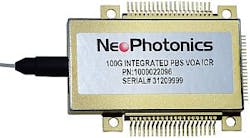NeoPhotonics coherent receiver improves OSNR

A PIC-based, 100G Variable Power Intradyne Coherent Receiver (VICR) integrates a variable optical attenuator (VOA) on the signal path. It is designed to increase dynamic range and improve the optical signal-to-noise ratio (OSNR) for both single-channel and multiple coincident signals. It allows providers to manage network capacity in colorless coherent networks.
NeoPhotonics
San Jose, CA
www.neophotonics.com
More Products
-----
PRESS RELEASE
NeoPhotonics Announces New Variable Power Intradyne Coherent Receiver (VICR) for High-Capacity 100G Optical Networks
New VICR is Designed to Improve Signal-to-Noise Ratio and Increase Coincident Channel Count in "Colorless" 100G Coherent Systems
Anaheim, California - NeoPhotonics Corporation (NYSE: NPTN), a leading designer and manufacturer of photonic integrated circuit, or PIC, based modules and subsystems for bandwidth-intensive, high speed communications networks, today announced a new 100G Variable Power Intradyne Coherent Receiver (VICR). The PIC-based VICR integrates a variable optical attenuator (VOA) on the signal path and is designed to increase dynamic range and improve the optical signal to noise ratio (OSNR) for both single channel and multiple coincident signals. This capability is designed to enable service providers to better manage network capacity in colorless coherent networks. NeoPhotonics is currently sampling the VICR and expects to enter general availability with this product in the second half of 2013.
Core networks are rapidly moving towards more efficient "colorless" operation, meaning that ROADM add and drop ports are not limited to fixed predetermined wavelength channels. Instead, a tunable transmitter can connect any wavelength to any add port and the ROADM can route any wavelength to any drop port receiver. Colorless operation improves the efficiency of valuable line cards and transponders in coherent transport networks, where a single DWDM channel carries 100Gbps of information.
In coherent optical communications systems the colorless channel drop operation is enabled by using the local oscillator laser and the VICR to select the receive channel, eliminating the need for a terminal optical filter. The VICR then detects the signal channel to which the local oscillator laser is matched, but all other channels are outside the device bandwidth. In colorless applications the remaining channels are not filtered out optically, so the incoming signal power to the VICR can vary significantly depending on how many other channels are present, resulting in up to 100 times higher power falling on the receiver than in the single channel case. The NeoPhotonics VICR integrates a PIC variable optical attenuator that provides control and stability to the input signal. In both colorless and conventional optically filtered systems, the VOA also improves performance by allowing system selection of the optimal operating point to enhance OSNR and reduce the effects of optical impairments such as polarization dependent loss (PDL).
"We are pleased to add the VICR to our extensive line of PIC based intradyne coherent receivers," said Tim Jenks, Chairman and CEO of NeoPhotonics. "The VICR illustrates the power of photonic integration to provide additional functionality to our existing products, which are designed to benefit our customers with improved performance in the same form factor and simplified board layouts."
About NeoPhotonics
NeoPhotonics is a leading designer and manufacturer of photonic integrated circuit, or PIC, based optoelectronic modules and subsystems for bandwidth-intensive, high-speed communications networks. The company's products enable cost-effective, high-speed data transmission and efficient allocation of bandwidth over communications networks. NeoPhotonics maintains headquarters in San Jose, California and ISO 9001:2000 certified engineering and manufacturing facilities in Silicon Valley (USA) and Shenzhen, China. For additional information, visit www.neophotonics.com.
-----
Follow us on Twitter
Subscribe now to Laser Focus World magazine; it's free!